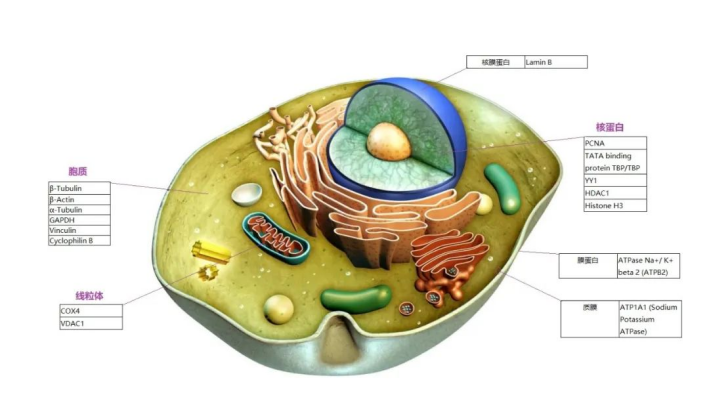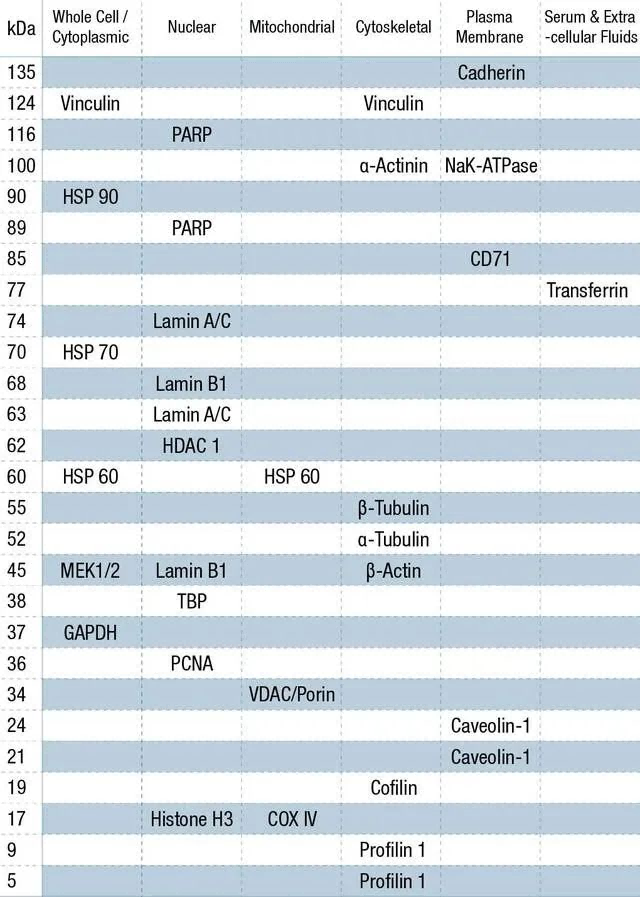

How to choose loading control antibodies
The loading control antibody can be used to evaluate the efficiency of Western Blot and compare the amount of protein loaded per well in the gel. Such controls can help identify differences in expression levels between samples, whether due to actual protein levels in cell lysates or differences in loading.
Key functions of loading control antibodies
(1) Check if the whole WB process is in order
(2) Testing for correct gene expression products
(3) Comparison of relative changes in trace amounts of products
(4) Evaluate whether the total amount of protein in each well is generally consistent

Figure 1 Example
Loading control antibodies are also used as positive controls for co-staining in immunofluorescence studies of target proteins. Loading control antibodies are divided into unlabelled and labelled types, and markers include biotin, HRP, FITC, PE, Cy dyes and Alexa Fluor dyes.
There are many types of loading control antibodies, such as β-actin, β-tubunlin, GAPDH, Vinculin, LaminB, PCNA, etc. The selection of different loading control antibodies for different samples is also the key to the success of WB experiments. This article will briefly describe five principles that should be followed in the selection of loading control antibodies.
I. Source of sample species.
The first thing to consider is what species the experimental sample comes from.
1. Mammalian tissue or cell samples, usually β-actin, β-tubulin, GAPDH, Lamin B, Histone H3, Na,Katpase etc. are selected.
2. For experimental samples of plant origin, plantactin, Rubisco, etc. are available.
3. There are fewer studies of samples from other sources, so it is appropriate to refer to journal literature data and select appropriate proteins as loading controls.
II. Molecular weight size.
When selecting a loading control antibody, the molecular weight of the target protein should be taken into account, generally ensuring that the difference between the molecular weight of the target protein and the loading control protein is more than 5 KD. For example, if the molecular weight of the target protein is 40 KD, it is not appropriate to choose β-actin or GAPDH as the loading control, but rather α-Tubulin or β-tubulin.
III. Level of expression.
The loading control protein selected needs to be highly expressed in the sample to be tested. Commonly used loading control proteins are those that are highly expressed by housekeeping genes and are required for cell development and maintenance of cell viability. For example, PCNA, an loading control protein in the nucleus, is expressed in the S phase of DNA and is therefore not recommended for non-proliferating cells.
IV. Target protein expression localization.


V. ELK Biotechnology Optional Related loading controls.
|
Scope of application |
Name |
Item No. |
Molecular weight |
|
cytoplasm |
β-Tubulin |
EM1114 |
50kDa |
|
β-Actin |
EM1031 |
43kDa |
|
|
Alpha-Tubulin |
EM1115 |
52kDa |
|
|
GAPDH |
EM1028 |
37kDa |
|
|
Vinculin |
ES3700 |
123kDa |
|
|
Cyclophilin B |
EM1219 |
21kDa |
|
|
Nuclear membrane proteins |
Lamin B |
EM1035 |
68kDa |
|
Nucleoproteins |
PCNA |
EM1030 |
29kDa |
|
TATA binding protein TBP/TBP |
EM1216 |
38kDa |
|
|
YY1 |
ES11233 |
45kDa |
|
|
HDAC1 |
ES4225 |
55kDa |
|
|
Histone H3 |
EM1037 |
15kDa |
|
|
Membrane proteins |
ATPase Na+/ K+ beta 2 (ATPB2) |
/ |
112kDa |
|
Plasma membrane |
ATP1A1 (Sodium Potassium ATPase) |
ES2892 |
100kDa |
|
Mitochondria |
COX4 |
EM1032 |
15kDa |
|
VDAC1 |
ES4120 |
31kDa |
|
|
Full blood/ Plasma/ Serum |
Transferrin |
EM1231 |
77kDa |
|
Albumin |
EM1190 |
66kDa |
|
|
Plant |
Plant actin |
EM1147 |
43kDa |


